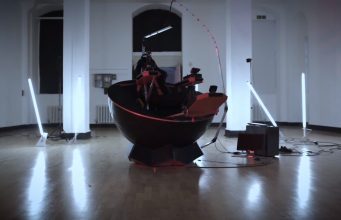
Feel Three, a 3DOF motion simulator for VR, went live on Kickstarter yesterday. And owing to its vision in providing a relatively cost-effective solution among a sea of expensive motion platforms, the company blasted past their £50,000 funding goal within only a day’s time.
The simulator is built on a half-sphere base, which sits atop a number of motors and special omnidirectional wheels, called ‘omni wheels’, that give the user three degrees of freedom: pitch, roll and yaw. Because of its relatively inexpensive design—it doesn’t include costly linear actuators, which can set you back around £1,000 to £2,000 each—the Feel Three is touted as an affordable solution, starting at £2,000 (~$2,570) for Super Early Birds.
“You’re lifting the user up and down [with linear actuators], which is really expensive mechanically—it takes a lot of power. So by using just omni wheels and DC motors, we can move the user quite quickly. They sit at the center of gravity, they’re balanced. It’s just a simpler solution,” says project founder Mark Towner.
The platform also includes tactile transducers, which add vibration from the game in several places, giving you an extra hit of immersion by letting you feel engine revs, gunfire and other impacts. The system’s tactile transducers are placed by your feet, hands and back.
Because it’s a device intended for VR users, tracking is also an important aspect. According to the Kickstarter page, a tracker near the player’s head “constantly updates the orientation of the sphere and cancels the movement of the simulator from the players view.” This is where a pain point arrises however:
“We need to track the platform and uses these readings to cancel the movement in your headset. Many motion simulators have a small range of pitch and roll so the user can simply keep looking forward despite the movement and chance of discomfort. This then means their view will float around in the car as they drive, which is fine for some people, not ok for others.”
Since the platform’s range of movement is so dramatic, motion cancellation will have to be figured out before it’s a perfect fit. Some of the ways the company suggest conquering this challenge include: individual game support, native engine support through Unreal or Unity, an API wrapper (which could break after headset software updates), native support through OpenXR, or native support from headset manufacturers. The company is currently boasting over 100 compatible games, some of which are non-VR games that can be played via a virtual screen while in-headset.
Still, it’s clear this sort of motion platform will appeal to VR simulator enthusiasts looking to fly in Elite Dangerous (2014) or drive in Project Cars 2 (2017), so Feel Three also includes a removable armrest plate so you can swap out and safely bolt down controllers. The final package is said to include armrest plates with pre-drilled holes for “the most popular controllers,” although the company will also provide a chart for other controllers so you can DIY your own setup.
As for steering wheels and center-mounted flight yokes, those can can be attached to what the creators call “a lightweight optional shelf which is attached to both armrests and can be rotated forward to let the user enter the cockpit.”
The company is providing their own software suite to control Feel Three, allowing users to adjust the speed and intensity of each game, as well as set limits on their physical rotation.
As a lower-tier item for £400 (~$515), backers can also choose the simulator’s static cockpit piece, which includes a chair mount, armrests, pedal shelf, and four 60W tactile transducers.
Hardware Specs
- Pitch/Roll: 90/100 degrees
- Yaw limit: 3600 degrees +
- Speed: 70-120 degrees/sec (roll & pitch)
- Weight: 60 kg sphere, 25 kg base (total 85 kg or ~187 lbs)
- Power requirement base: 220/110V 600W
- Power requirement sphere: 220/110V 600W
- User height: 140-200 cm (~4 foot 7 inches – 6 foot 7 inches)
- User weight limit 3/6 wheels: 110 kg (~240 lbs) / 135 kg (~300 lbs)
- Materials: 98% aluminium
- PC requirements: Win 8+, two USB 2.0
Check out the Kickstarter campaign here, which includes a comprehensive FAQ.
The post VR Motion Simulator ‘Feel Three’ Hits Kickstarter, Fully Funded in Under 24 Hours appeared first on Road to VR.
from Road to VR https://ift.tt/2wubQbW
via IFTTT
No comments:
Post a Comment